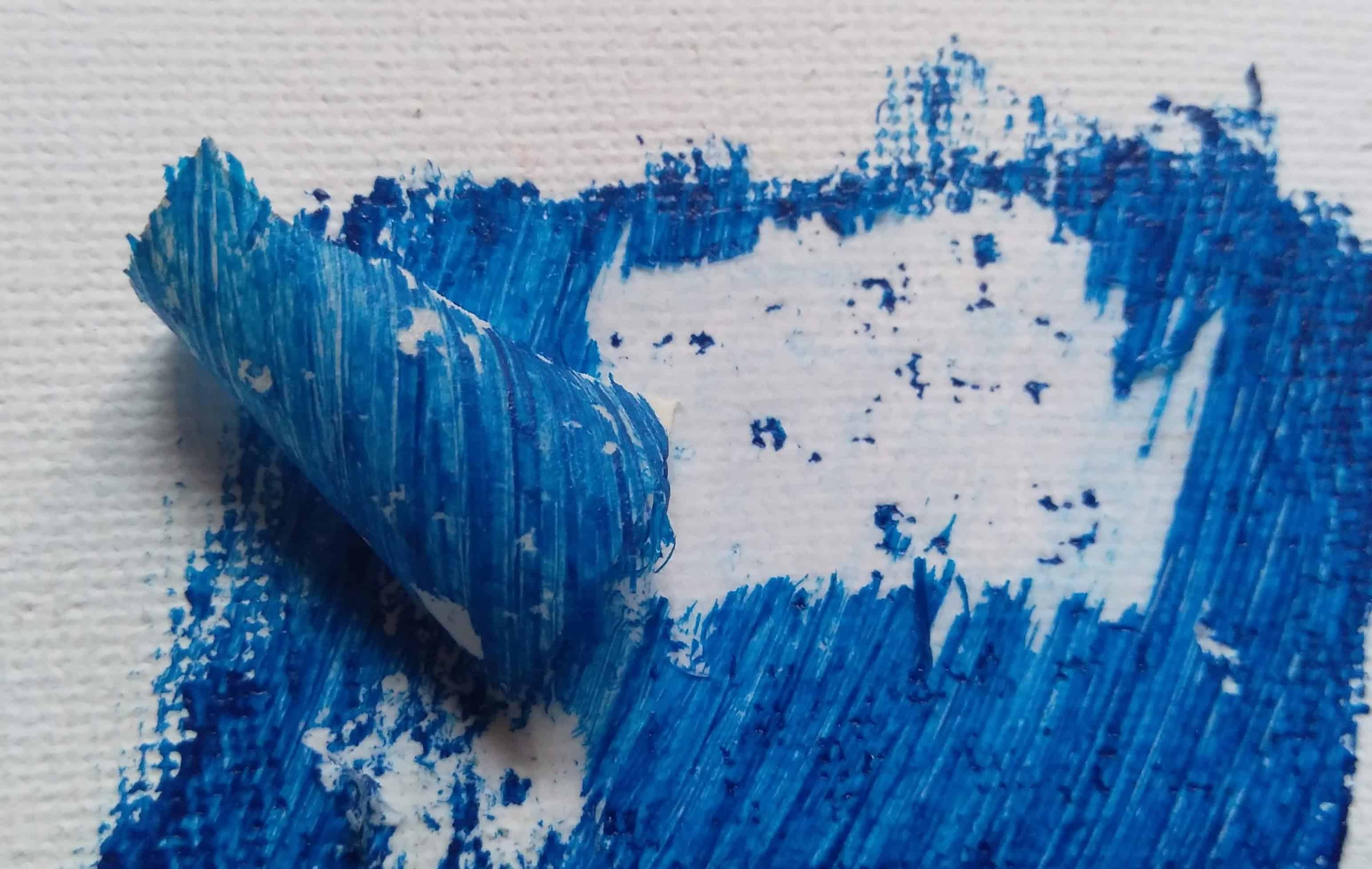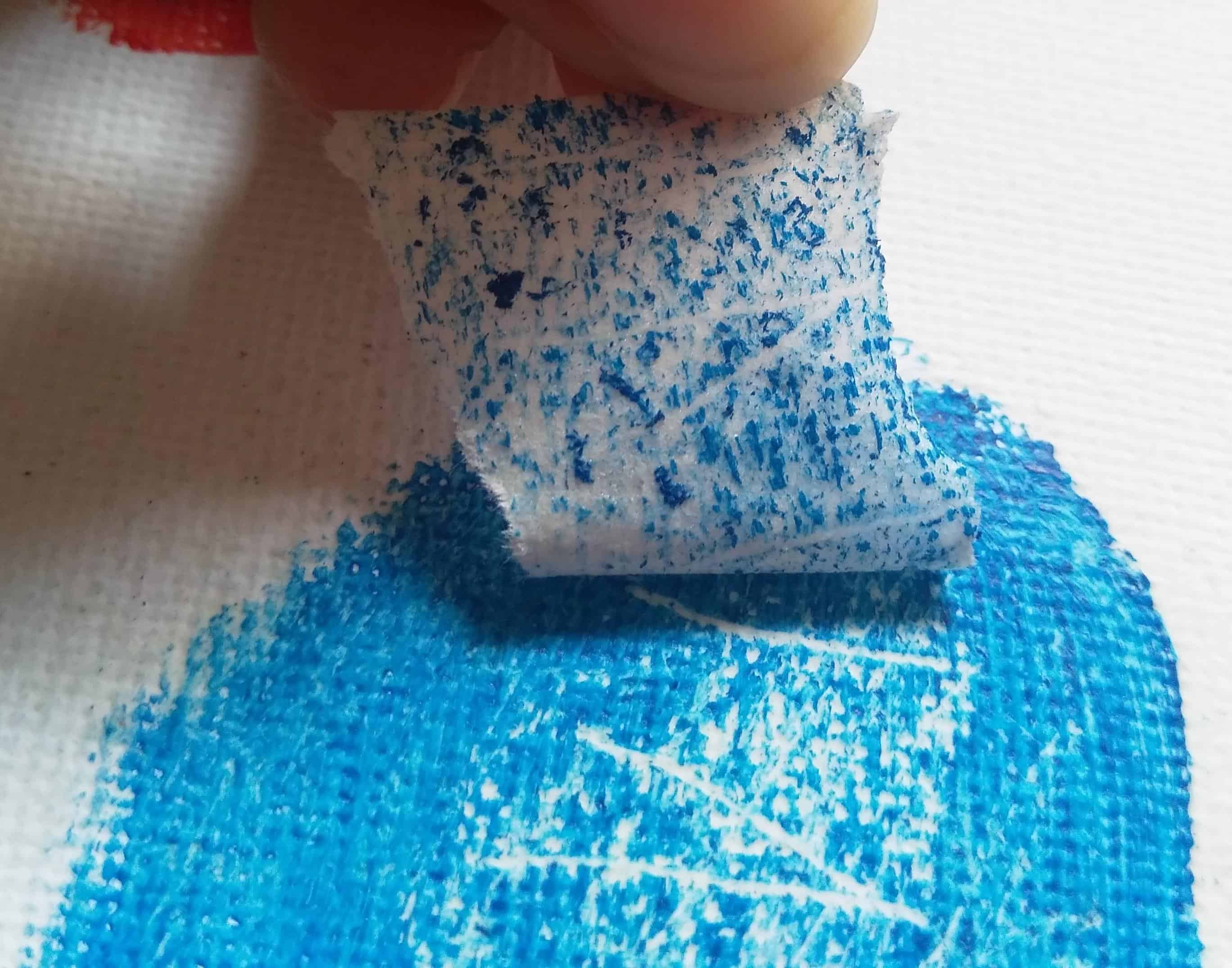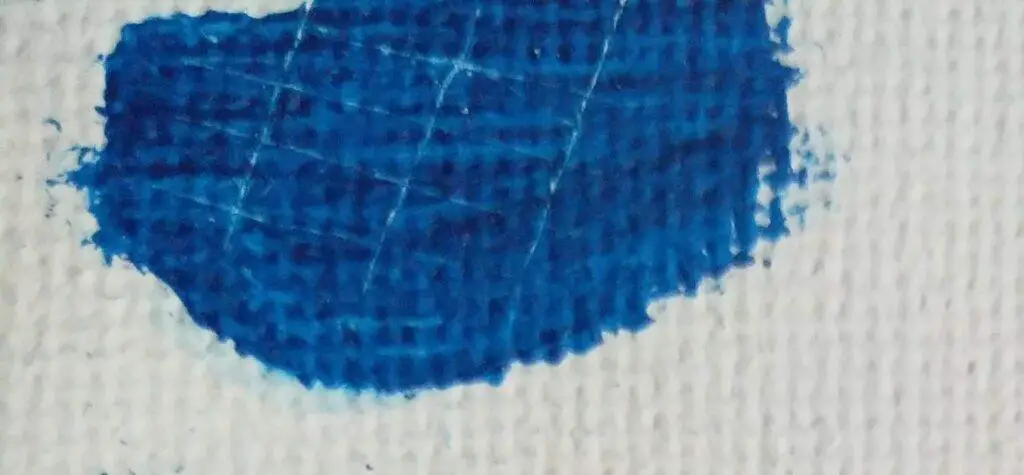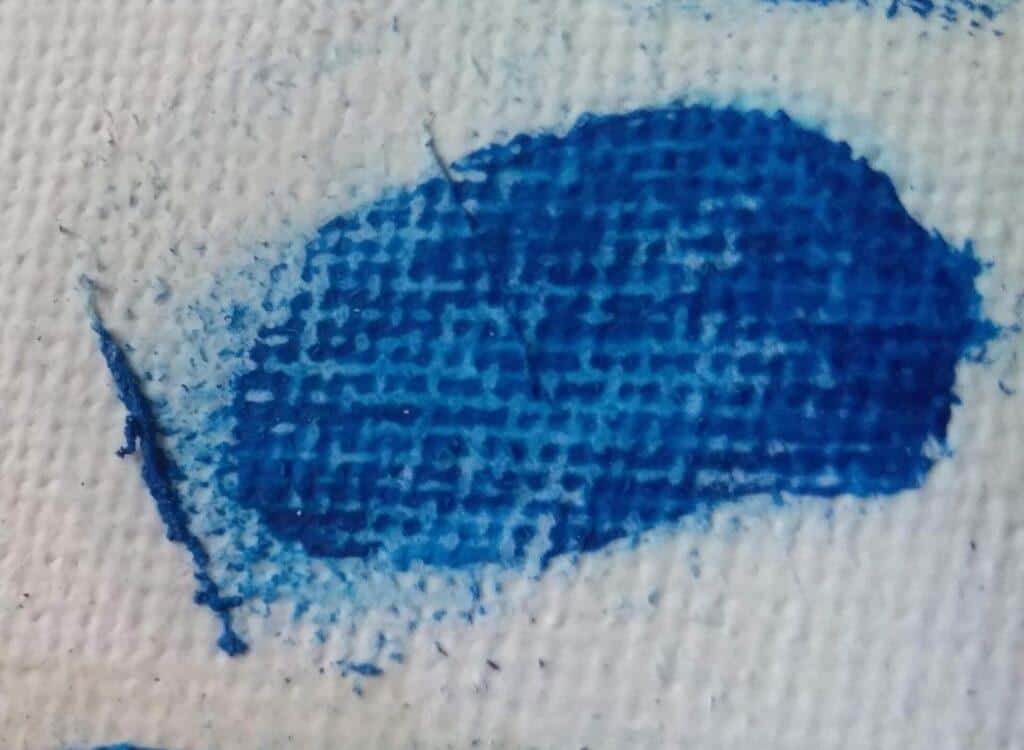As a beginner in acrylic painting, it can be overwhelming to learn everything you need to know. However, knowing the answers to common acrylic painting questions will make you a fast learner. It will make a good headstart for you. Following are some common acrylic painting questions you need to know the answers to.
I have answered many acrylic paint questions in the ‘common acrylic paint questions and answers: part 2‘ article. There you can find things like the best ways to fix your damaged acrylic paintbrushes.
Does acrylic paint scratch easily?
Acrylic paint scratch easily on waxed, greased, shiny, smooth, and hard surfaces. If contact with water after drying the paint, the paint film will peel off easily. To reduce scratching, sanding, and priming the surface before painting, and sealing the finished painting with a quality varnish helps.
The following images show the scratching of acrylic paint on waxy, greasy, gessoed, and moisture surfaces. I used a paper knife to scratch the paint in a crosshatch pattern. Then I burnished a masking tape on top of each surface and peeled it off to see if any paint come off with the tape. It is an indicator of poor adhesion.




As you can see, to prevent acrylic paint from scratching, always make sure the painting surface does not have any grease or wax on it. Also avoid any water on the surface before and after painting, unless it is for mixing paint. Make sure you paint on a fully dry surface, especially if painting on wood or concrete.
You can remove grease and wax by sanding the surface. If it is a hard shiny surface like plastic, glass, or metal, you can wash the surface first with water and soap, and then with alcohol. This can remove any oil or grease on the surface.
Always make sure to prime the surface before painting with acrylics. Gesso is a great option for priming. Gesso help paints to stick better to a surface, reducing scratching. The surface needs to be free from moisture after painting.
One of the best ways to prevent scratching is to finish the painting with a sealer. Krylon has a great range of acrylic paint sealers that are scratch-resistant when compared to other brands. My favorite is Krylon Statin Finish. You can choose any finishing from Krylon according to your needs, it can be matte, gloss, or statin.
If you are interested to know if acrylic paint is waterproof you can read the following article: Is acrylic paint waterproof? What you need to know
Why does my acrylic paint look streaky?
Acrylic paintings can look streaky when using too thick or thin paint, painting with stiff, thick bristled brushes, and putting more pressure when painting. They can be avoided by using the paint with the right consistency, a soft-bristled brush, open acrylic mediums, and putting less pressure when blending.
We always dream of smooth seamless blending. But sometimes streaks happen. Streaks can happen if your paint is not of the right consistency. If you thin down your paint with too much water, the paint will be seen through with the edges of the paint. On the other hand, if the paint is too thick, the colors will be harder to blend.
Wetting your brush when painting helps to avoid streaks. But if your brush is dripping wet, it will drop on the painting. If you blot the water droplet, you will have to redo the painting in that area.
Another thing that could create streaks is painting with a stiff and thick-bristled brush. Unlike a soft bristle brush, stiff bristle brushes will not create a smooth blending effect without streaks. Make sure you do not use a very smooth bristle brush that cannot hold paint. Rather you can use a smooth brush that is hard enough to hold the paint.
The high pressure of the brush on canvas can also cause streaks, especially when you are blending the colors. Sometimes you may need more pressure on the brush to blend the colors. But use less pressure whenever possible to blend colors to avoid streaks.
If you want to get rid of streaks and blend colors at the same time, open acrylics help a lot. Open acrylics dry slowly and give you more time to blend. This way you can avoid the streaks due to paint drying fast on canvas. You will have the super blending ability.
I wrote a whole article on the best ways to avoid streaks and blotches in acrylic paintings. You will 10 best tips and techniques to create seamless color blends there.
The best open acrylic you can buy is Golden Open Acrylics. You can also use Golden Open Acrylic Mediums. They can do wonders when it comes to blending colors, especially in matching skin tones in portrait painting. It will give you the feel of oil paints but without any toxic solvents. You can thin open acrylics with water like any other acrylics.
Does acrylic paint go bad?
Acrylic paint can last for decades if handled properly and kept in a proper environment. Acrylic paint expiration accelerates if the paint is low in quality, stored in a high-temperature environment, exposed to direct sunlight or UV light, keeping the bottles open, and contaminations by brushes.
When paintings are kept in high heat, moisture in the paint evaporates (acrylic paint is a combination of pigments, binder, and water as the solvent) so severely. This can cause cracking, peeling, or crumbling of the paint. When this happens to paint, it is nearly impossible to save them. Cracking, peeling, and fading can happen to paintings on canvases.
I have written a whole article about ‘how long acrylic paint will last‘ where I have compared the shelf life of different acrylic paint brands. You will find in-depth answers to this question in that article.
I have also written an article ‘How can you tell if acrylic paint is bad? (common signs)’. You will also find the best practices to prevent acrylic paint from going bad in that article.
Why does my acrylic paint smell bad?
Acrylic paint can smell bad when it got expired or is contaminated with bacteria. They have a sour-aged smell. To avoid contaminations, use a palette knife to take paint from the container, keep brushes clean and dry after painting, use high-quality paint and close the paint tubes with a tight-fitting lid.
Always make sure you use a palette knife to take your paint out. Do not use a brush to put inside the paint container and take the paint out. Brushes are surfaces where bacteria can easily lie. Always use clean brushes.
There are many other ways acrylic paint can go bad. Such as being chunky, stringy, and moldy. You find more details about acrylic paint going bad and the common signs of bad acrylic paints in my article ‘How can you tell if acrylic paint is bad?‘
Why does my acrylic paint look chalky?
Acrylic paint can look chalky and less vibrant when too much water is added, using low-quality paint and making both shadows and highlights cool. To fix this, add only 25% water or mediums to thin the paint, use artist-quality or student-grade acrylics, and use some warm colors in the painting.
Adding too much water to acrylic paint thins out the paint too much to the point acrylic paint binder cannot bind the pigment (color) particles together. So that, the colors can become chalky, and less vibrant. Make sure you do not add more than 25% water when diluting.
You can also use matte or gloss mediums to thin the paint. Acrylic mediums have binders in them. So you can add as much medium to thin paint without breaking the acrylic polymer binder.
Using very low-quality, craft paints can leave you with chalky dull paintings. It can even discourage you from painting further. But the problem is with your paint and not with your techniques. So, always invest in high-quality paint to get a vibrant and less chalky look to your paintings.
Adding white to any color reduces its value and can look chalky if you add too much white to the paint. It will make the mixed color cooler. To make the color a little bright and warm, you need to do mixing a warmer color such as yellow, orange, or red. It will reduce the chalky and washed-out look.
But adding a warmer color does not work always. So you can mix the whitish color with a cooler color. You can increase the chroma or intensity of the color by mixing a cooler color like blue. This will reduce the chalky look or the milky look of the whitish paint. The following video explains this concept well.
Chalky paintings happen when both your shadows and highlights are cooler. What you can do is make either shadow or highlights warmer. This way you can reduce the chalky look of the painting. You can mix warmer colors such as yellow, red, or orange.
Muddy painting happens when both the shadows and highlights of the painting are warmer. You can make either of those cooler to reduce the muddiness of the painting. Blue and green are some cooler colors you can use in the painting.
I have written a whole article about the 17 pros and cons of acrylic paint. You can find all the important aspects of acrylic paint there.
Why is my acrylic paint not covering it?
Acrylic paint does not cover well when there is less concentration of pigment or transparent pigments. These can be fixed by using artist-quality paint instead of student-quality paint, adding titanium white to paint, and using opaque pigments instead of transparent pigments in acrylic paints.
Low-quality craft or student acrylic paint has less pigment concentration and more fillers. Meaning it will take many layers of paint to cover what is underneath the paint. This is not a problem with artist-quality acrylic paint. Artist-quality acrylics have high pigment concentration. So it covers well.
You can also mix artist-quality titanium white with paint. As artist-quality titanium white is highly pigmented, it will cover better.
Sometimes the problem is not with the quality of paint, but rather with the type of pigment in the paint. There are both transparent and opaque pigments. You will need both of these pigments in paintings. Sometimes you need to cover what is underneath. Other times you will need to glaze it over with transparent paint.
I have researched the 2 best acrylic paint brands which are Golden and Liquitex, and summarized, what are their opaque, semi-opaque, semi-transparent, and transparent colors. I looked at their artist-quality acrylic range as well as student quality acrylic range of Liquitex (Liquitex Basics).
The following is what I have found. I have only included pure pigmented colors in the table. I did not include any pigment mixtures. It is always better to avoid pigment mixtures. Rather you can buy a few pure pigmented colors and mix others by yourself.
Liquitex Basics common acrylic color pigment information
| Color | Opaque | Semi-opaque | Transparent |
| Brown | Raw Umber Burnt Umber | ||
| Green | Phthalocyanine Green | ||
| Black | Ivory Black Mars Black | Titanium White | |
| White | Titanium White | ||
| Yellow | Yellow Oxide | Transparent Yellow | |
| Violet or magenta | Dioxazine Purple | Quinacridone Magenta | |
| Orange | |||
| Red | Pyrrole Red | Naphthol Crimson Primary Red | Transparent Red |
| Blue | Ultramarine Blue |
Liquitex Professional’s common acrylic color pigment information
| Color | Opaque | Semi-opaque | Semi-transparent | Transparent |
| Brown | Raw Sienna Burnt Sienna Raw Umber | Transparent Raw Sienna Transparent Burnt Sienna | ||
| Green | Cobalt Turquoise Cobalt Green Chromium Oxide Green | Phthalocyanine Green Blue Shade Phthalocyanine Green Yellow Shade Green Gold | ||
| Black | Ivory Black Iridescent Black Mars Black | |||
| White | Titanium White | Transparent Mixing White | ||
| Yellow | Cadmium Yellow Light Cadmium Yellow Medium Cadmium-Free Yellow Deep Yellow Oxide | Yellow Medium Azo | Yellow Light Hansa Yellow Orange Azo Indian Yellow | |
| Violet or magenta | Quinacridone Magenta Dioxazine Purple Quinacridone Blue Violet | |||
| Orange | Cadmium Orange | Pyrrole Orange | Quinacridone Burnt Orange Quinacridone Red-Orange | |
| Red | Cadmium Red Light Cadmium Red Medium Pyrrole Red Red Oxide Pyrrole Crimson | Naphthol Red Light Naphthol Crimson Van Dyke Red | Quinacridone Red-Orange Quinacridone Red Quinacridone Crimson | |
| Blue | Cobalt Blue Cerulean Blue Cobalt Teal | Indanthrene Blue Ultramarine Blue Red Shade Ultramarine Blue Green Shade Phthalocyanine Blue Red Shade Phthalocyanine Blue Green Shade |
Golden Artist common acrylic color pigment information
| Color | Opaque | Semi-opaque | Semi-transparent | Transparent |
| Brown | Burnt Sienna Burnt Umber Raw Umber | Burnt Umber Light Raw Sienna | Transparent Brown Iron Oxide | |
| Green | Chromium Oxide Green Chromium Oxide Green Dark | Cobalt Green Cobalt Turquoise | Phthalo Green (Blue Shade) Phthalo Green (Yellow Shade) | |
| Black | Carbon Black Mars Black Graphite Gray | Bone Black | ||
| White | Titanium White | Zinc White | ||
| Yellow | Cadmium Yellow Dark Cadmium Yellow Light Cadmium Yellow Medium Cadmium Yellow Primrose Mars Yellow | Bismuth Vanadate Yellow Diarylide Yellow Hansa Yellow Opaque Titanate Yellow Yellow Ochre Yellow Oxide | Primary Yellow Benzimidazolone Yellow Medium | Nickel Azo Yellow Transparent Yellow Iron Oxide Benzimidazolone Yellow Light |
| Violet or magenta | Violet Oxide | Primary Magenta | Dioxazine Purple Quinacridone Magenta Quinacridone Violet Ultramarine Violet | |
| Orange | Cadmium Orange | Vat Orange Pyrrole Orange | ||
| Red | Cadmium Red Dark Cadmium Red Light Cadmium Red Medium Red Oxide | Naphthol Red Medium Pyrrole Red Pyrrole Red Dark Pyrrole Red Light | Naphthol Red Light | Quinacridone Red Transparent Red Iron Oxide |
| Blue | Cerulean Blue, Chromium Cerulean Blue Deep Cobalt Turquoise Cerulean Blue Deep Cobalt Teal | Anthraquinone Blue Cobalt Blue Ultramarine Blue | Phthalo Blue (Green Shade) Phthalo Blue (Red Shade) |
If you want better coverage, make sure you choose from opaque or semi-opaque colors. As you can see, the same colors have different opacities with different brands. Be sure to check the label when you buy paint. Artist-quality acrylics have their opacity indicated on the label.
Also with Liquitex basics, you can see there are only a few pure pigments, and I have included them all in the table. This is the reason why you need to avoid student or craft quality paint and go for artist-quality acrylic paint.
I have written a whole article about ‘Why is acrylic paint not covering? (and how to fix it)‘ in detail.
You might also need to make transparent acrylic paints. Here have written a whole article about 8 Easy ways how to make acrylic paint transparent. There you can find both free and other best options to make acrylic paint transparent.
Why won’t my acrylic paint stick to the canvas?
Acrylic paint generally does not stick to pre-primed canvases, due to oil, or grease on the surface, low-quality gesso on the canvas, low-quality paint, and thinning the paint too much. These can be solved by, applying 2 to 3 coats of gesso, adding only 25% water to thin the paint, and using artist-quality paint.
acrylic paint not sticking problem usually occurs with cheap pre-primed canvases you buy from the store. Either they use a low-quality primer or there is grease or oil on the primed surface which reduces the adhesion.
Canvases can be contaminated with grease, dust, or oil. This can be due to damage to the plastic wrap they have wrapped in and touching the surface of the canvas. Also, if the surface is not primed well with gesso, the canvas can absorb more paint into it, making it harder to smooth the paint out.
Because of these reasons, store-brought canvases need to be primed by yourself. You can use acrylic gesso for this. Sand the canvas surface with fine-grit sandpaper lightly before priming a pre-primed canvas. Apply 2 to 3 coats of gesso and sand between the coats.
I have written a whole article about acrylic paint not sticking to the canvas. You can find 5 common reasons for this and ways to avoid them in that article.
The following video explains why we need to gesso a pre-primed canvas and how to do it well.
It is always a best practice to use no more than 25 % water in acrylic paint when painting on a canvas. Because thinning down the paint too much breaks the acrylic polymer structure that binds the pigment together. Hence too much water will reduce the binding ability to paint on canvas.
I have written a whole article about how to use acrylic paint with water. You will know whether to wet the brush before painting or not and the different effects you can get with varying amounts of water.
I have also written an article about what acrylic paint will not stick to. You will know what to avoid when it comes to sticking acrylic paint. Also how to stick acrylic paint on many other surfaces and keep it off.
Should you paint a canvas white before painting?
Canvases need to be painted with white or black gesso before painting. It is a best practice to paint a tonal ground on top of the gesso. The tonal ground will show through any patches where there are no layers of paint. White is usually used on top layers of acrylic painting for details.
When you first bought a canvas or made a canvas for yourself, you need to prime it with gesso. Gesso has an acrylic polymer binder and titanium white pigments in it giving gesso a white color. It provides teeth and adhesion to the surface so paint adheres better to the canvas. It also reduces paint absorption into the canvas and promotes the smooth application of paint.
Canvas is not necessarily painted with white, but it is a gesso that you see on the surface of a canvas. You need to do all of the painting on top of the gesso and never directly on an unprimed canvas.
Doing a tonal ground on top of the gesso helps the painting to be done quicker, easily establishes the tones of the painting, easily brings the mood to your painting, and levels up your painting quality. The following video explains how to make a tonal ground and the importance of it by Will Kemp.
Is acrylic paint water-based?
Almost all acrylic paints that we use today are water-based made by suspending color pigments in an acrylic polymer-water emulsion. However, acrylic paints were first developed as solvent-based paint for artists in the early twenties. The water-based acrylic paint that we use today are developed and launched in 1955.
The acrylic paint you use today contains 20%- 60% acrylic polymer (binder), 25% – 50% of pigments and extenders, 10% to 50% of water, and 10% to 20% additives. Water is what keeps the acrylic paint fluid in the paint container. This is called the solvent.
I have written a whole article about ‘Is acrylic paint water-based?‘. You can find more details on the most common water-based acrylic paints and solvent-based acrylic paints that are not common among artists in that article.
I have also written an article comparing the differences between other water-based paint and acrylic paint. You will also get a handy chart that summarizes the differences in that article.
Why is your acrylic paint sticky?
Acrylic painting is sticky when the painting is not fully cured, has poor ventilation, high humidity, uses low-quality paints, and has thick painting layers. Avoiding the above aspects when painting, finishing with varnish or sealer, and using parchment papers in between paintings can fix this problem.
Acrylic paint is sticky in the phase between wet and fully cured. Water in the paint film is what causes acrylic paint to be sticky. When the paint is fully cured there is absolutely no water in the paint film. The paint film is hard and dry. The curing period of acrylic paint normally takes between 3 to 4 weeks.
However, there are many ways around waiting until the painting is fully cured to stop acrylic painting from sticking. I have discussed them in detail in the article ‘Why is your acrylic paint sticky: 10 best ways to fix it.
Do you need an easel to paint?
Many artists prefer using an easel when painting, to prevent the distortion of the viewing angle, have a perception of freedom, and better hand movements. It helps improve the painting. However, some artists only prefer flat surfaces for painting while other artists prefer both easel and tabletop.
Investing in an easel is a very good choice for a beginner artist. But if you cannot afford one, painting on the tabletop is also fine. The most important thing is to start painting. You can keep the painting on the tabletop and see if you like that.
However, there are ways around buying an easel and there are other options some artists use better than easels. You can find all those information from the article I have written ‘Do you need an easel to paint? (and what others prefer)‘.
Why does acrylic paint have bubbles?
Bubbles on acrylic paints occur when air is trapped inside the paint by vigorously mixing paint, using cheap acrylic paints, the composition of the painting mix, and the humidity of the environment. You can get rid of them using a toothpick, blow torch, heat gun, or mixing dish soap water with paint.
Bubbles in acrylic paint are very common when you are doing acrylic pours. You can prevent them by letting the paint sit overnight before doing an acrylic pour, mixing in a little dish soap, and having the right consistency. I have discussed them in detail in my article ‘Why does acrylic paint have bubbles: how to fix, prevent‘
Why acrylic paint is cracking?
Acrylic paint cracks when the top paint layer dries faster than the layers below causing uneven paint drying. It is influenced by thick paint layers, high airflow, cold temperatures, low-quality paint, and the movement of the painting and not preparing the painting surface.
If you are interested to find more information about acrylic paint cracking you can read the following article: Acrylic paint cracking: why, how to prevent and fix
This is the end of common acrylic paint questions part 1. Hope to answer your questions in part 2 of the series. Happy painting!


